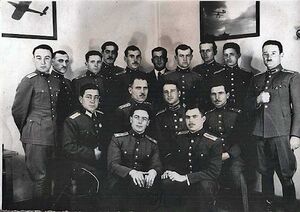Aristokrati
The Aristokrati ("Aristocrats") was a Social class of Syaran society during the Republic of Syara. The Aristokrati referred to members of the Syaran populace who could trace their lineage and blood ties through the former nobility of the Makedonian Empire and to a lesser extent Galania. Although not a legally recognized class of citizens, the Aristokrati held immense influence in the political and social life of the Republic, especially during its early years.
The concept of the Aristokrati had changed over the course of Syaran history. During Hellenic Syara the Aristokrati typically referred to the elite of the Makedonian Empire, especially those with ties or influence with the Royal Court. This was often considered synonymous with the Makedonian nobility, though officially Makedonian nobles referred to the members of the hetairoi, or companions, of the Makedonian King and their families. During the Empire, Aristokrati came to mean wealthy land owners in addition to members of the nobility, who came to represent the political and financial elite of the Empire. The concept of the Aristokrati persisted beyond the Fall of the Makedonian Empire and many wealthy families retained their status even after the Arkoennite conquest and the establishment of the Makedonian Khanate.
The defeat of the Makedonian Rebellion by the Arkoennites and subsequent rise of the Rioni Union led to the Aristokrati becoming dominated by the royal family of Galania and their prominent supporters, although many Makedonian elite remained part of the Aristokrati. During the period of the Syaran Successor States the Aristokrati effectively became two separate groups within the Kingdom of Makedon and the Kingdom of Galania, but both held similar positions within their respective nations. Following the Galanian-Ruvelkan War and the Ruvelkan-Makedonian War the Unification of Syara saw the two groups merged once again. While the Republic's Constitution held no specific clause or section dedicated to outlining the role or even existence of the Aristokrati, the class continued to thrive amid the Republic's rapid industrialization.
Composed mostly of wealthy landowners, friends to the royal houses of Makedon and Galania, and prominent industrialists and merchants, the Aristokrati dominated the early Republic's government and politics. By 1922 more than 70% of Syaran senators and nearly 65% of the officer corps of the Armed Forces of the Syaran Republic consisted of members of the Aristokrati. The Syaran-Ruvelkan War and Divide War both impacted the influence of the Aristokrati, in particular the surge in Syaran nationalism following victory over the Cacertian Empire in 1918. Nationalist pride in Syaran history, particular the Makedonian Empire and its historic dominion over Siduri helped propel Sasko Anastasov into the office of President despite his commoner origins, and the Aristokrati benefited significantly Anastasov's ultra-nationalistic administration.
The Siduri War would mark the beginning of the end of the Aristokrati. Despite composing less than 10% of the population, the Aristokrati families accounted for nearly 20% of all casualties suffered by the Republic during the conflict. Entire bloodlines, some of which had persisted for more than a millennia, were eliminated, depriving the Aristokrati of a future generation of leaders and politicians. The decimation of the Aristokrati set the stage for the downfall of the Republic as the Syaran government, society, and military were increasingly composed of lower-class citizens from Scitaria and Hayreniky, who lacked the royal lineage and blood ties of their Makedonian and Galanian counterparts. By the 1970s the Syaran Senate was increasingly dominated by anti-aristocratic and anti-royalist elements, most noticeably the Wardens who sought to eliminate the last remnants of elitist rule in Syara.
The Refusal War marked the end of the Aristokrati, who almost entirely sided with the Royalists. Their defeat and confiscation of many estates and wealth from the remaining Aristokrati, coupled with the writing and adoption of the Commonality Constitution, officially ended any claimants to titles of nobility or aristocracy in Syara.
